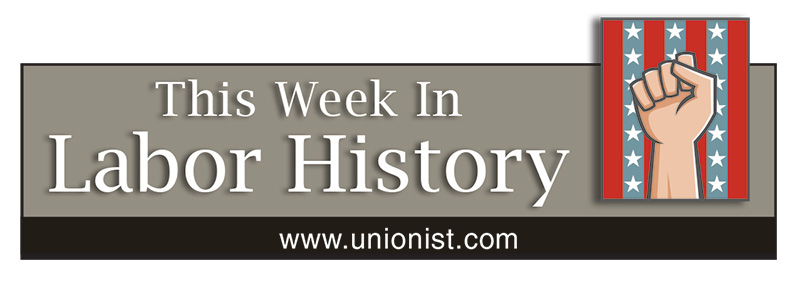
OCTOBER 26
1825 – After eight years and at least 1,000 worker deaths — mostly Irish immigrants — the 350-mile Erie Canal opens, linking the Great Lakes and the Atlantic Ocean. Father John Raho wrote to his bishop that “so many die that there is hardly any time to give Extreme Unction (last rites) to everybody. We run night and day to assist the sick.”
OCTOBER 27
1904 – The New York City subway, the first rapid-transit system in America, opens. More than 100 workers died during the construction of the first 13 miles of tunnels and track.
1935 – Three strikes on works-relief projects in Maryland were underway today, with charges that Depression-era Works Projects Administration jobs were paying only about 28 cents an hour — far less than was possible on direct relief. Civic officials in Cumberland, where authorities had established a 50-cent-per-hour minimum wage, supported the strikers.
1951 – The National Labor Council is formed in Cincinnati to unite Black workers in the struggle for full economic, political and social equality. The group was to function for five years before disbanding, having forced many AFL and CIO unions to adopt non-discrimination policies.
OCTOBER 28
1879 – Union organizer and anarchist Luisa Capetillo is born in Arecibo, Puerto Rico. She organized tobacco and other agricultural workers in Puerto Rico and later in New York and Florida. In 1916 she led a successful sugar cane strike of more than 40,000 workers on the island. She demanded that her union endorse voting rights for women. In 1919, three years before her death, she was arrested for wearing pants in public, the first woman in Puerto Rico to do so. The charges were dropped.
1965 – The St. Louis Gateway Arch is completed after two and one-half years. Originally sold as a jobs program for thousands of African-Americans in St. Louis suffering from the Depression, the 630-foot high arch of stainless steel marks the Jefferson National Expansion Memorial on the waterfront of St. Louis. Although it was predicted 13 lives would be lost in construction, not a single worker died.
OCTOBER 29
1889 – Japanese immigrant and labor advocate Katsu Goto is strangled to death, his body then strung from an electric pole, on the Big Island of Hawaii by thugs hired by plantation owners. They were outraged over Goto’s work on behalf of agricultural workers and because he opened a general store that competed with the owners’ own company store.
1929 – Wall Street crashes — “Black Tuesday” — throwing the world’s economy into a years-long crisis including an unemployment rate in the U.S. that by 1933 hit nearly 25 percent.
OCTOBER 30
1986 – Ed Meese, attorney general in the Ronald Reagan administration, urges employers to begin spying on workers “in locker rooms, parking lots, shipping and mail room areas and even the nearby taverns” to try to catch them using drugs.
1991 – The fishing boat Andrea Gail, out of Gloucester, Mass., is caught in a ferocious storm and lost at sea with her crew of six. The event inspired the book, The Perfect Storm, by Sebastian Junger, and a film by the same name. The city of Gloucester has lost more than 10,000 whalers and fishermen to the sea over its 350-year history.
OCTOBER 31
1829 – George Henry Evans publishes the first issue of the Working Man’s Advocate, “edited by a Mechanic” for the “useful and industrious classes” in New York City. He focused on the inequities between the “portion of society living in luxury and idleness” and those “groaning under the oppressions and miseries imposed on them.”
1891 – Tennessee sends in leased convict laborers to break a coal miners strike in Anderson County. The miners revolted, burned the stockades and sent the captured convicts by train back to Knoxville.
1941 – After 14 years of labor by 400 stonemasons, the Mt. Rushmore sculpture is completed in Keystone, S.D.
NOVEMBER 1
1835 – In the nation’s first general strike for a 10-hour day, 300 armed Irish longshoremen march through the streets of Philadelphia calling on other workers to join them. Some 20,000 did, from clerks to bricklayers to city employees and other occupations. The city announced a 10-hour workday within the week; private employers followed suit three weeks later.
1887 – Thirty-seven Black striking Louisiana sugar workers are murdered when Louisiana militia, aided by bands of “prominent citizens,” shoot unarmed workers trying to get a dollar-per-day wage. Two strike leaders are lynched.
1918 – Malbone tunnel disaster in New York City; inexperienced scab motorman crashes five-car train during strike, 97 killed, 255 injured.
1919 – Some 400,000 soft coal miners strike for higher wages and shorter hours.
1979 – The UAW begins what was to become a successful 172-day strike against International Harvester. The union turned back company demands for weakened work rules, mandatory overtime.
1982 – Honda assembles the first-ever Japanese car manufactured in a U.S. plant, in Marysville, Ohio.
(Compiled by David Prosten, founder of Union Communication Services)

